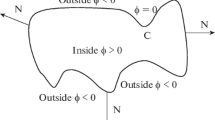Abstract
Segmentation images into several parts are an important task in many image processing and computer image applications. The purpose of dividing a photo into several parts involves segmentation the image into different regions based on the criteria for future processing. One of the methods of segmentation the images is the growth method of the area. In this study, the region’s growth method is used to segment the brain MRI images. The method of growing the area consists of several steps. In the beginning, you have to select a few initial points (seeds) that are related to the areas to be separated from the field. Then, starting from these points in the neighborhood of these points, checked the other points and if added according to the selectivity similarity criterion belonging to the first point region. In this research, the selection of initial points is done automatically. For this purpose, the genetic algorithm is used which searches for the optimal initial points using the initial population selection and the definition of the proper fitness function. Investigating the result of the proposed method on the images compared with the region’s growth method by manually selecting the initial points indicates that this method can well improve the segmentation of the brain MRI image.







Similar content being viewed by others
References
Awate, S. P., Tasdizen, T., Foster, N., & Whitaker, R. T. (2006). Adaptive Markov modeling for mutual-information-based, unsupervised MRI brain-tissue classification. Medical Image Analysis, 10, 726–739. https://doi.org/10.1016/j.media.2006.07.002.
Ho, B. C. (2007). MRI brain volume abnormalities in young, nonpsychotic relatives of schizophrenia probands are associated with subsequent prodromal symptoms. Schizophrenia Research, 96, 1–13. https://doi.org/10.1016/j.schres.2007.08.001.
Rostami, M. T., Ghaderi, R., & Ghasemi, J. (2013) Neural network for enhancement of FCM based brain MRI segmentation. In 2013 13th Iranian conference on fuzzy systems (IFSC) (pp. 1–4). IEEE. https://doi.org/10.1109/ifsc.2013.6675661.
Sahoo, P. K., Soltani, S. A. K. C., & Wong, A. K. (1988). A survey of thresholding techniques. Computer vision, graphics, and image processing, 41(2), 233–260. https://doi.org/10.1016/0734-189X(88)90022-9.
Pohle, R., & Toennies, K. D. (2001). Segmentation of medical images using adaptive region growing (pp. 1337–1346). http://dx.doi.org/10.1117/12.431013.
Ahmadvand, A., Sharififar, M., & Daliri, M. R. (2015). Supervised segmentation of MRI brain images using combination of multiple classifiers. Australasian physical and engineering sciences in medicine, 38, 241–253. https://doi.org/10.1007/s13246-015-0352-7.
Dunn, J. C. (1973). A fuzzy relative of the ISODATA process and its use in detecting compact well-separated clusters. Journal of Systemics, Cybernetics and Informatics, 3, 32–57. https://doi.org/10.1080/01969727308546046.
Zangeneh, D., & Yazdi, M. (2016). Automatic segmentation of multiple sclerosis lesions in brain MRI using constrained GMM and genetic algorithm. In 2016 24 th Iranian conference on electrical engineering (ICEE).
Vincent, L., & Soille, P. (1991). Watersheds in digital spaces: an efficient algorithm based on immersion simulations. IEEE Transactions on Pattern Analysis and Machine Intelligence, 13, 583–598. https://doi.org/10.1109/34.87344.
Young, T. (2017). An active contours for segmentation of images of low contrast blurred boundaries, 978-15090-5957-7/17 IEEE.
Ibrahim, W. H., Osman, A. A. A., & Mohamed, Y. I. (2013). MRI brain image classification using neural networks. In 2013 international conference on computing, electrical and electronic engineering (ICCEEE) (pp. 253–258). IEEE. https://doi.org/10.1109/icceee.2013.6633943.
Song, Z., Tustison, N., Avants, B., & Gee, J. C. (2006). Integrated graph cuts for brain MRI segmentation. In R. Larsen, M. Nielsen, & J. Sporring (Eds.), International conference on medical image computing and computer-assisted intervention (pp. 831–838). Berlin: Springer. https://doi.org/10.1007/11866763_102.
Balafar, M. A., Ramli, A. R., Saripan, M. I., & Mashohor, S. (2010). Review of brain MRI image segmentation methods. Artificial Intelligence Review, 33, 261–274. https://doi.org/10.1007/s10462-010-9155-0.
Mohd Saad, N., Abu-Bakar, S., Muda, A. S., Mokji, M., & Abdullah, A. R. (2012). Automated region growing for segmentation of brain lesion in diffusion-weighted MRI. In 2012 international multiconference of engineers and computer scientists, IMECS 2012.
Chen, H., Zhen, X., Gu, X., Yan, H., Cervino, L., Xiao, Y., et al. (2015). SPARSE: seed point auto-generation for random walks segmentation enhancement in medical inhomogeneous targets delineation of morphological MR and CT images. Journal of applied clinical medical physics, 16(2), 387–402.
Gomez, O., Gonzalez, J. A., & Morales, E. F. (2007). Image segmentation using automatic seeded region growing instance-based learning. Mexico: National Institute of Astrophysics, Optics and Electronics Computer Science Department, Luis Enrique Erro Num 1, Puebla.
Shih, F. Y., & Cheng, S. (2005). Automatic seeded region growing for color image segmentation. Image and Vision Computing, 23(10), 877–886.
Khalid, N. E. A., Ibrahim, S., Manaf, M., & Ngah, U. K. (2010). Seed-based region growing study for brain abnormalities segmentation. In 2010 international symposium on information technology (Vol. 2, pp. 856–860). IEEE. https://doi.org/10.1109/itsim.20https://doi.org/10.5561560.
WebBrain Database. (2015). Online Link http//brainweb.bic.mni.mcgill.ca/brainweb/anatomic_normal_20.html. (pp. 7:1–7:26). https://doi.org/10.1155/2008/581371.
Li, C., Xu, C., Anderson, A. W., & Gore, J. C. (2009). MRI tissue classification and bias field estimation based on coherent local intensity clustering: A unified energy minimization framework. In J. Prince, D. Pham, K. Myers (Eds.) International conference on information processing in medical imaging (pp. 288–299). Berlin: Springer. https://doi.org/10.1007/978-3-642-02498-6_24.
Natteshan, N. V. S., & Jothi, J. A. A. (2015). Automatic classification of brain mri images using svm and neural network classifiers. In M. E.-S. El-Alfy, M. S. Thampi, H. Takagi, S. Piramuthu, T. Hanne (Eds.), Advances in intelligent informatics (pp. 19–30). Cham: Springer. https://doi.org/10.1007/978-3-319-11218-3_3.
Zhang, J.-S., & Leung, Y.-W. (2004). Improved possibilistic C-means clustering algorithms. IEEE Transactions on Fuzzy Systems, 12, 209–217. https://doi.org/10.1109/TFUZZ.2004.825079.
Author information
Authors and Affiliations
Corresponding author
Additional information
Publisher's Note
Springer Nature remains neutral with regard to jurisdictional claims in published maps and institutional affiliations.
Rights and permissions
About this article
Cite this article
Dehdasht-Heydari, R., Gholami, S. Automatic Seeded Region Growing (ASRG) Using Genetic Algorithm for Brain MRI Segmentation. Wireless Pers Commun 109, 897–908 (2019). https://doi.org/10.1007/s11277-019-06596-4
Published:
Issue Date:
DOI: https://doi.org/10.1007/s11277-019-06596-4




